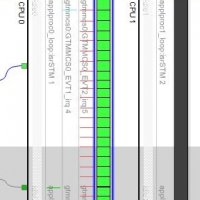The difficulty of showing that real-time software safely executes within an allotted time budget arises from the variability of code execution time. Some of this variation arises from hardware effects but a great deal arises from different paths through software.
We can reduce and even eliminate this variation at the expense of increased code size and average-case performance. Consider the following expression for saturating arithmetic:
uint32 double_uint32( uint32 x )
{
if( x > MAX / 2 )
{
x = MAX;
}
else
{
x *= 2;
}
return x;
}
This can be rewritten as:
uint32 double_uint32( uint32 x )
{
uint32 uf_mask = ((uint64)MAX / 2 - x) >> 32;
/* If x > MAX / 2 then the subtraction results in an
* unsigned underflow, with the result that
* 'uf_mask' is 0xFFFFFFFF.
* Otherwise 'uf_mask' is 0.
*/
x = ((x * 2) & ~uf_mask) | (MAX & uf_mask);
return x;
}
Similar transformations can be used to force all computation to be done using a single path, i.e. to remove all software causes of timing variation. This can lead to extremely poor performance, for example when two large functions are always called rather than just selecting one of them, but it is a powerful technique that can be used selectively to eliminate path variations that impair testability or introduce damaging timing jitter.
With regard to testing, note that such techniques make a mockery of MC/DC testing. The requirement for either version of double_uint32 is that the range boundary values (normally min-1, min, max and max+1) be explored. However MC/DC reporting will not differentiate between proper testing of the transformed version and simply calling it once with any value.

 Rapita System Announces New Distribution Partnership with COONTEC
Rapita System Announces New Distribution Partnership with COONTEC
 Rapita partners with Asterios Technologies to deliver solutions in multicore certification
Rapita partners with Asterios Technologies to deliver solutions in multicore certification
 SAIF Autonomy to use RVS to verify their groundbreaking AI platform
SAIF Autonomy to use RVS to verify their groundbreaking AI platform
 What does AMACC Rev B mean for multicore certification?
What does AMACC Rev B mean for multicore certification?
 How emulation can reduce avionics verification costs: Sim68020
How emulation can reduce avionics verification costs: Sim68020
 Multicore timing analysis: to instrument or not to instrument
Multicore timing analysis: to instrument or not to instrument
 How to certify multicore processors - what is everyone asking?
How to certify multicore processors - what is everyone asking?
 Certifying Unmanned Aircraft Systems
Certifying Unmanned Aircraft Systems
 DO-278A Guidance: Introduction to RTCA DO-278 approval
DO-278A Guidance: Introduction to RTCA DO-278 approval
 ISO 26262
ISO 26262
 Data Coupling & Control Coupling
Data Coupling & Control Coupling
 DASC 2025
DASC 2025
 DO-178C Multicore In-person Training (Fort Worth, TX)
DO-178C Multicore In-person Training (Fort Worth, TX)
 DO-178C Multicore In-person Training (Toulouse)
DO-178C Multicore In-person Training (Toulouse)
 HISC 2025
HISC 2025

















